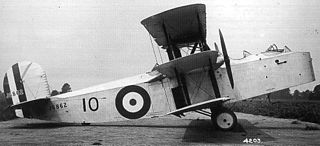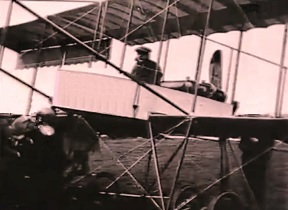
The Roe I Triplane was an early aircraft designed and built by A.V. Roe which was the first all-British aircraft to fly..

The Roe III Triplane was an early aircraft designed by the British aircraft manufacturer Avro. In configuration, it was similar to the Roe II Triplane, with a triplane tailplane and an open-top fuselage of triangular cross-section, but the Roe III was a two-seater, and featured ailerons for the first time in a Roe design. The five production machines differed from the prototype in having the ailerons fitted to the middle wing and in being powered by a Green engine in place of the prototype's JAP.

The Avro Type D was an aircraft built in 1911 by the pioneer British aircraft designer A.V. Roe. Roe had previously built and flown several aircraft at Brooklands, most being tractor layout triplanes. The Type D was his first biplane.

The Avro Type E, Type 500, and Type 502 made up a family of early British military aircraft, regarded by Alliott Verdon Roe as his firm's first truly successful design. It was a forerunner of the Avro 504, one of the outstanding aircraft of the First World War.

The Blackburn Triplane was a single-engine pusher single-seater, designed specifically to attack Zeppelins. It flew in 1917, but was not successful.

The de Havilland DH.27 Derby was a large single-engined biplane designed to a heavy day bomber Air Ministry specification. It did not reach production.
The Avro 528 was an unsuccessful large span single-engined biplane built to an Admiralty contract in 1916. It carried a crew of two; only one was built.

The Parnall Possum was an experimental triplane, with a single, central engine driving wing-mounted propellers via shafts and gears. Two of these British aircraft were built in the mid-1920s.
The Surrey Flying Services AL.1 was a single-engined side-by-side two-seat training biplane, built at a UK flying club in 1929. Only one was built, but it was flying until the outbreak of war in 1939 and remains in storage.
The Perry Beadle T.1 was a single-seat, single engine biplane built and flown in the United Kingdom in 1913. In 1914 it flew with a more powerful engine and other modifications as the Perry Beadle T.2, which was acquired by the Royal Navy Air Service at the outbreak of World War I.
The Gaunt biplane no.2 'Baby' was a single-engine, single-seat biplane, designed by John Gaunt and flown by him with some success from Southport sands in Lancashire, England during the summer of 1911.

The ASL Viking was a single-engined two seater biplane aircraft designed and built by Horatio Barber's Aeronautical Syndicate Ltd. at Hendon. It was first flown in January 1912.
The Gabardini biplane was an Italian single seat biplane, designed and built near the beginning of World War I. It was an advanced trainer and could be fitted with engines of output between about 40 to 80 kW.

The Koolhoven Heidevogel was one of the first Dutch aircraft, an improvement of the popular Farman type.

The Hanriot HD.15 was a French two seat fighter aircraft fitted with a supercharger for good high altitude performance, built in the 1920s. Three were ordered by Japan but lost at sea during delivery.

The Albatros L.71 was a two-seat, single pusher engined biplane built in Germany in the 1920s.

The 1910 Deperdussin monoplane, is a general term for a variety of Deperdussin aircraft models built between 1910 and 1911. Initially released in August 1910, it was the first aircraft to be built in significant quantities by Aéroplanes Deperdussin. Many variations of the aircraft were produced, differing in size, engine type and horsepower and tail configuration. These were loosely labelled as the "Deperdussin monoplane", but were sometimes more specifically classified either by function or by seating-type. A number of Deperdussin monoplanes were flown successfully in air races and gained several speed and endurance records during 1911–1912. Several have survived, including an airworthy example in the Shuttleworth Collection in England.

The Caudron C.140 was a French tandem cockpit sesquiplane designed in 1928 as a combination of liaison aircraft and observer and gunnery trainer.

The Caudron C.74 was a ten-seat, four engine passenger biplane built in France in 1922. It showed promise but the sole prototype crashed fatally in a competition and no more were completed.
The Itoh Emi 13 was a two seat Japanese trainer, designed for the Itoh flying school and introduced in two versions in 1920 and 1921.















